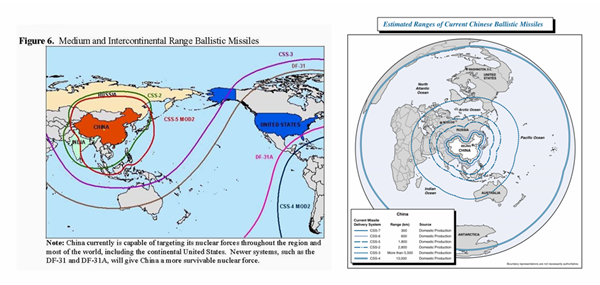The Defense Department has issued its Annual Report of the Military Power of the People’s Republic of China for 2005. Although the report was the subject of extensive debate, the final document appears relatively mundane. It contains, unlike past reports, a large amount of detailed information—although there are some quality control problems.
The data dump, though, seems to be overwhelming some of my colleagues.
I want to disagree with something that appeared in the Nelson Report, subsequently picked up by The Agonist. The Nelson Report identified a “new” piece of information that might make headlines (admittedly, Chris is mocking the alarmist nature of the press):
9. Here’s an item which is just ripe for “dramatic” press stories, so long as not accompanied by serious discussion of the difference between “capability” and “threat”, when one includes politics and the facts of life in defining “threat”: the report states for the first time that China’s 20 ICBMs have been modified to increase their range to cover all the US, not just a small slice, as in the past.
— a color map shows that the entire United States except for Florida (is Jeb Bush that good?!)is now within range of these 20 ICBM nuclear missiles. Previous reports had not, at least in the unclassified version, indicated that entire US population for the first time is within range of Chinese ICBMs. This could be a headline for some newspapers – “China Now Can Destroys Most US Cities” – due to improvements made apparently in the past few years, but not in prior DOD public reports.
Chris is making humorous point with which I agree, but—lest someone take this seriously—the facts are not quite right.
Range information for the CSS-4 (DF-5) has been previously made public in DOD reports. Also, Chris has the wrong range line for the CSS-4, which is capable of reaching everywhere in the US and always has been.
Here is a comparison of the chart from the 2005 Chinese Military Power (left) and the 1997 edition of Proliferation: Threat and Response (right).

Morever, the “modification” program (creating the CSS-4 Mod 2) is old news, having appeared in the 1998 Ballistic and Cruise Missile Threat and 1999 Cox Report. Reporters asked General Eugene Habiger, then-STRATCOM Commander about reports China was improving the range of its existing ballistic missiles. Habiger was unimpressed:
Q: Was all this debate just a lot of hot air?
A: I’m not going to into debates and hot air. Let me tell you that the CSS-4 ICBM that the Chinese have deployed today has been deployed since 1981. And there have been some modifications, but nothing significant.
All this aside, the report contains slightly more detail than past IC products, including the revelation that the IC thinks the CSS-3 has a refire capability (something I had previously suspected, but couldn’t prove).
Here is the chart (I dropped the SRBMs, which aren’t thought to have nuclear warheads).
Figure 13 China’s Missile Forces China’s Missile Inventory
| Missile | Total Launchers/Missiles | Estimated Range |
|---|---|---|
| CSS-4 ICBM | 20/20 | 8,460+ km |
| CSS-3 ICBM | 10-14/20-24 | 5,470+ km |
| CSS-2 IRBM | 6-10/14-18 | 2,790+ km |
| CSS-5 MRBM Mod 1/2 | 34-38/19-23 | 1,770+ km |
| JL-1 SLBM | 10-14/10-14 | 1,770+ km |
| DF-31 ICBM | DEVELOPMENTAL | 7,250+ km |
| DF-31A ICBM | DEVELOPMENTAL | 11,270+ km |
I am not sure why the authors omitted the JL-2 or labeled the JL-1 as deployed (since it pretty clearly is not, based on other IC statements).
